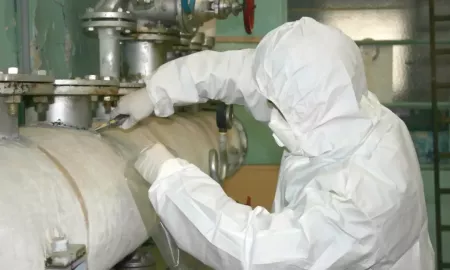Despite numerous guidance documents and online resources published by the HSE detailing the selection, use and maintenance of RPE, many businesses and workplaces still manage to get it wrong.

The HSE estimates that there are around 12,000 deaths from lung diseases in the UK each year that are caused by exposure to airborne contaminants in the workplace, with around 5.5 million employees at risk of respiratory diseases. To put this in perspective, in 2017/18 there were 144 workers killed by fatal accidents at work such as falls from height. In other words, there are considerably more work-related deaths as a consequence of ill health than poor safety. This highlights a clear need for more stringent controls to be implemented when it comes to protection from airborne contaminants.
With the recent release of HSE document INDG 479, respiratory protective equipment (RPE) has once again come to the fore as a method of controlling airborne contaminants in the workplace. Although the least favourable control option, in terms of the hierarchy of control, RPE remains the most commonly used control method for airborne contaminants in many industries. The control of airborne contaminants should form part of a COSHH (Control of Substances Hazardous to Health) assessment, which is required by law to control exposure and protect workers’ health.
However, despite numerous guidance documents and online resources published by the HSE detailing the selection, use and maintenance of RPE, many businesses and workplaces still manage to get it wrong. Many businesses also see it as the most obvious method of control, but the HSE states that it should only be used when:
- There is a residual risk after other control methods are enacted
- As an interim measure while other control measures are put in place
- For emergency work or during a temporary failure of controls
- For short term infrequent exposures such as maintenance work
Assessing the need for control measures
The first stage to assessing the need for control methods is to identify any hazards within the workplace. Once a hazard is identified, the risk needs to be assessed, and this may be backed up by exposure monitoring by trained and competent personnel. If, following the risk assessment, it is found that respiratory protection is required as part of an overall system of control, then a number of steps need to be followed in order to achieve the desired protection for workers.
Firstly, a respirator needs to be chosen that: provides suitable protection, is comfortable to wear, is compatible with other PPE requirements on site and achieves a correct seal around the face. Face fit testing is required under COSHH regulation 7(9) for any tight-fitting masks and can be completed in both a qualitative and quantitative manner. Subsequently, training will need to be provided on cleaning schedules, storage of RPE and tool box talks on how to properly use and don masks.
Common examples of misuse with respiratory protective equipment
There are a number of mistakes commonly seen in industry regarding RPE, including:
- Incorrect selection of RPE - even down to the basics, if protection is required against a gas or vapour, a respirator that protects against dust will be useless.
- Incorrect selection of assigned protection factor (APF) - if a contaminant is present at 15x the workplace exposure limit (WEL) a respirator with an APF of at least 20 will need to be selected
- A lack of face fit testing being conducted - even if the correct APF is selected, without face fit testing, the mask may not be providing protection to the wearer at the quoted level
- Employees with facial hair - any tight-fitting mask requires a cleanly shaven face in order to achieve a correct fit around the wearers facial features. However, positive pressure powered hood respirators are suitable for use by those with facial hair
- Incorrect storage of RPE - in the workplace, it is common to see respirators left on a workbench collecting settled dust and contaminants which will then be inhaled when the mask is next worn
- Repeated use of disposable respirators - although cheap to purchase, disposable respirators are designed for single shift use, and yet it is common to find employees repeatedly using the same disposable respirator. It may be more economically viable to invest in reusable respirators, denoted by an R on the mask.
- Extended use of tight-fitting RPE - the HSE recommends tight-fitting masks are worn for no longer than an hour; however, they are often worn for the full duration of the shift
Having followed UK legislation, care still needs to be taken when relying on respirators to provide adequate protection. A study on the effectiveness of respirators using human subjects by Lee et al. (2016) found that 18% of FFP2 respirators had actual protection factors of <10 and 42% of FFP3 respirators had protection factors of <20 for particles in the range 0.093-1.61µm. Further to this, although there is legislation enacted in the UK for initial face fit testing of individuals, there is no legislation for repeat testing. A study conducted by Zhuang et al. (2016) found that the predicted risk of an unacceptable fit increased over time, from 10% a year on from an initial fit test, to 20% at 2 years and 25% at 3 years.
Ensuring correct use of RPE
Overall respiratory protective equipment can provide a vital last line of defence from airborne contaminants. However, there is still an over-reliance and vast misuse of RPE within most industries. The employers’ responsibilities should not end with provision but should also extend to employee training in selection, use, maintenance and storage. Employees need to use RPE in accordance with the manufacturer’s instructions as well as in line with the training and instruction that employers provide.
References:
Lee et al. (2016) https://www.hindawi.com/journals/jhe/2016/8572493/
Zhuang et al. (2016) https://www.ncbi.nlm.nih.gov/pmc/articles/PMC5505322/
HSE (2013) http://www.hse.gov.uk/pubns/books/hsg53.htm
Want to find out more about SOCOTEC's health and safety services?

You might also like







Add new comment